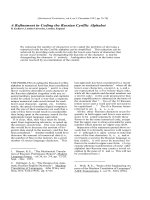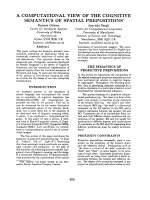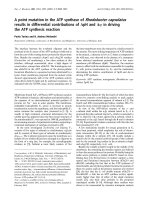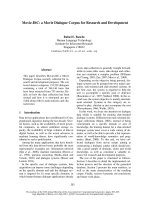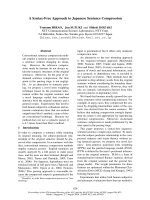Báo cáo khoa học: "A Hemodynamic monitoring over the past 10 years" pot
Bạn đang xem bản rút gọn của tài liệu. Xem và tải ngay bản đầy đủ của tài liệu tại đây (39.57 KB, 3 trang )
Page 1 of 3
(page number not for citation purposes)
DO
2
= total body oxygen delivery; PAC = pulmonary artery catheter; pCO
2
= tissue partial pressure of carbon dioxide; pO
2
= tissue partial pres-
sure of oxygen; SO
2
= percentage saturation of hemoglobin with oxygen; SpO
2
= arterial oxygen saturation; SvO
2
= mixed venous saturation of O
2
.
Available online />Abstract
Changes in hemodynamic monitoring over the past 10 years have
followed two paths. First, there has been a progressive decrease in
invasive monitoring, most notably a reduction in the use of the
pulmonary artery catheter because of a presumed lack of efficacy
in its use in the management of critically ill patients, with an
increased use of less invasive monitoring requiring only central
venous and arterial catheterization to derive the same data.
Second, numerous clinical trials have documented improved
outcome and decreased costs when early goal-directed
protocolized therapies are used in appropriate patient populations,
such as patients with septic shock presenting to Emergency
Departments and high-risk surgical patients before surgery (pre-
optimization) and immediately after surgery (post-optimization).
Novel monitoring will be driven more by its role in improving
outcomes than in the technical abilities of the manufacturers.
Hemodynamic monitoring is a cornerstone in the care of the
hemodynamically unstable patient. It serves as a monitor both
of stability and acute deterioration and of response to therapy.
Although hemodynamic monitoring is also both context specific
and disease specific, it is primarily driven by technology and
offset by utility. Nothing underscores this concept better than
the decline in the use of the pulmonary artery catheter (PAC),
whose use has markedly decreased while its ability to measure
increasingly more hemodynamic variables increased [1]. In its
ultimate format the PAC continuously measures temperature,
heart rate, mixed venous saturation of O
2
(SvO
2
), cardiac
output, right ventricular ejection fraction and end-diastolic
volume, central venous pressure and pulmonary arterial
pressure. When coupled with non-invasive pulse oximetry, it
can also give total body oxygen delivery (DO
2
) and
consumption (VO
2
). Yet despite these impressive abilities, use
of the PAC has decreased primarily because few, if any, clinical
trials have shown that this litany of information improves
management enough to alter patient outcome [2].
Clearly, the primary changes in hemodynamic monitoring over
the past 10 years can be summarized as a decrease in use of
the PAC with a greater use of measures, presumed to be less
invasive, to derive the same hemodynamic data, and the
institution of protocolized resuscitation approaches driven by
selective hemodynamic measures. The initial logic for these
trends is not clear because, until recently, patient outcomes
have not been shown to be better when these data are
available from the PAC, so why would outcomes improve if
these same data are now available other means? Still, the
major thrusts were in the realm of alternatives to the PAC,
such as esophageal Doppler estimates of cardiac output [3]
and arterial pressure pulse contour and signal processing
estimates of stroke volume [4]. Furthermore, using only central
venous and arterial access one can also measure central
venous percentage saturation of hemoglobin with oxygen
(SO
2
), cardiac output and other more esoteric parameters
such as global cardiac volumes and lung water [5]. Although
other technologies studied over the past 10 years focused on
regional blood flow – examples are measures of splanchnic
blood flow from a PAC inserted into a hepatic vein, gastric
mucosal blood flow from gastric tonometry, and liver function
by indocyanide green dye clearance – the generalized use of
these monitoring techniques has never caught on, primarily
because they were not associated with improved patient
outcomes. Importantly, no monitoring device, no matter how
accurate or complete, would be expected to improve patient
outcome, unless coupled to a treatment that itself improves
outcome [6]. This basic truth underscores the theme that has
been increasingly commonly heard, namely that technology
should not drive monitoring: improved outcomes-defined
treatments should.
Thus, several important clinical trials have documented that
early aggressive resuscitation approached with guidance
from defined hemodynamic variables using thoughtful
protocols may improve outcome. Rivers et al. [7] showed that
an aggressive resuscitation protocol guided by central venous
SO
2
and pulse oximetry (arterial oxygen saturation (SpO
2
))
and delivered in an Emergency Department improved
Commentary
Hemodynamic monitoring over the past 10 years
Michael R Pinsky
University of Pittsburgh School of Medicine, 606 Scaife Hall, 3550 Terrace Street, Pittsburgh, PA15261, USA
Corresponding author: Michael R Pinsky,
Published: 9 February 2006 Critical Care 2006, 10:117 (doi:10.1186/cc3997)
This article is online at />© 2006 BioMed Central Ltd
Page 2 of 3
(page number not for citation purposes)
Critical Care Vol 10 No 1 Pinsky
outcome in patients with septic shock. This study was in
contrast with the numerous earlier studies showing the futility
of aggressive resuscitation once shock is established [8,9], or
when PAC insertion is not associated with an aggressive
resuscitation protocol [2,10]. The concept underscored by
this newer trial was that appropriate resuscitation prevents
subsequent tissue injury even if overt shock is present, if the
resuscitation is performed early enough.
The race was then on to identify other patient subsets whose
outcomes could be improved by similar aggressive
resuscitation approaches. Spurred on by the initial work of
Shoemaker et al. [11], who showed that high-risk surgical
patients could have their mortality decreased by a pre-
emptive resuscitation protocol aimed at achieving a high
initial DO
2
, referred to then as ‘survivor levels of DO
2
’.
Although this study was criticized for not having proper
control groups, it did demonstrate that preventing initial
ischemia may be useful. These findings were supported by
Boyd et al. [12], who also demonstrated a survival advantage
in preemptive resuscitation. This therapeutic philosophy has
been referred to a ‘pre-optimization’ to distinguish itself from
treatment of patients already in shock. Importantly, the recent
literature has shown that pre-optimization protocols improve
outcome [13] and are cost-effective [14]. Because pre-
optimization approaches focus on maximizing DO
2
before
surgery in high-risk patients, hemodynamic measures of blood
flow are all that are needed to accomplish these goals.
Carrying this theme forward, recent studies have shown that
in similar high-risk surgery patients, the use of aggressive
fluid resuscitation in the immediate postoperative period also
improves outcome, as measured by decreased length of stay
and hospital costs [3,4]. Importantly, these ‘post-optimization’
approaches also rely on measuring only blood pressure,
cardiac output, and SpO
2
, making them synchronous with the
instrumentation needed for pre-optimization protocols.
Finally, functional hemodynamic monitoring techniques, such
as measuring variation in pulse pressure [15] or in stroke
volume [16], have been shown to be robust markers of those
subjects with a high propensity for increasing cardiac output
if given a fluid challenge. Clinical trials using these
parameters to document efficacy will need to be done, but
will probably show that these measures also aid in defining
appropriate therapy when resuscitation is planned.
Thus, the future approaches to hemodynamic monitoring will,
at the least, focus on measures of cardiac output, arterial
pressure, and SvO
2
. To the extent that these measures can
be made continuously and in a non-invasive fashion they will
enjoy a wider degree of application and potentially prove
cost-effective. Finally, these measures will be made more
effective if coupled with parallel measurements of tissue
wellness with other monitoring techniques. Although
measures of sublingual tissue partial pressure of carbon
dioxide (pCO
2
), sublingual capillary blood flow, tissue partial
pressure of oxygen (pO
2
), pCO
2
, pH, and even NAD
+
/NADH
ratios can be made [17], their utility in the diagnosis of critical
illness and monitoring of response to therapy have yet to be
proven. The linkage between these non-invasive continuous
measures of metabolic function, global measures of
hemodynamic status and clinical outcomes needs to be made
and, if shown useful, may be the direction we take in the future
to guide us in the resuscitation of patients with critical illness.
Competing interests
MP is a medical advisor to Arrow International, Edwards
Lifesciences and LiDCO Ltd. MP and the University of Pittsburgh
co-own US patent no. 6,776,764, ‘Use of aortic pressure pulse
and flow in bedside hemodynamic management.’
References
1. Pinsky MR, Vincent J-L: Let us use the pulmonary artery
catheter correctly and only when we need it. Crit Care Med
2005, 33:1119-1122.
2. Richard C, Warszawski J, Anguel N, Deye N, Comes A, Barnoud
D, Boulain T, LeFort Y, Fartoukh M, Baud F, et al.: Early use of
the pulmonary artery catheter and outcomes in patients with
shock and acute respiratory distress syndrome: a randomized
controlled trial. JAMA 2003, 290:2713-2720.
3. McKendry M, McGloin H, Saberi D, Caudwell L, Brady AR, Singer
M: Randomised controlled trial assessing the impact of a
nurse delivered, flow monitored protocol for optimisation of
circulatory status after cardiac surgery. BMJ 2004, 329:258.
4. Pearse D, Dawson D, Fawcett J, Rhodes A, Grounds RM, Bennett
ED: Early goal-directed therapy after major surgery reduces
complications and duration of hospital stay. A randomized
controlled trial [ISRCTN38797445]. Crit Care 2005, 9:R687-
R693.
5. Sakka SG, Ruhl CC, Pfeiffer UJ, Beale R, McLuckie A, Reinhart K,
Meir-Hellmann G: Assessment of cardiac preload and extra-
vascular lung water by single transpulmonary thermodilution.
Intensive Care Med 2000, 26:180-187.
6. Pinsky MR, Payen D: Functional hemodynamic monitoring. Crit
Care 2005, 9:566-572.
7. Rivers E, Nguyen B, Havstad S, Ressler J, Muzzin A, Knoblich B,
Paterson E, Tomlanovich M: Early goal-directed therapy in the
treatment of severe sepsis and septic shock. N Engl J Med
2001, 345:1368-1377.
8. Gattinoni L, Brazzi L, Pelosi P, Latini R, Tognoni G, Pesenti A,
Fumagalli R: A trial of goal-oriented hemodynamic therapy in
critically ill patients. N Engl J Med 1995, 333:1025-1032.
9. Hayes MA, Timmins AC, Yau EH, Palazzo M, Hindo CJ, Watson
D: Evaluation of systemic oxygen delivery in the treatment of
the critically ill. N Engl J Med 1994, 330:1717-1722.
10. Yu DT, Platt R, Lanken PN, Black E, Sands K, Schwatrz J, Hibberd
PL, Graman PS, Kahn K, Snydman D, Parsonnet J, et al.: Rela-
tionship of pulmonary artery catheter use to mortality and
resource utilization in patients with severe sepsis. Crit Care
Med 2003, 31:2734-2741.
11. Shoemaker WC, Appel PL, Kram HB, Waxman K, Lee TS:
Prospective trial of supranormal values of survivors as thera-
peutic goals in high-risk surgical patients. Chest 1988, 94:
1176-1186.
12. Boyd O, Grounds M, Bennett ED: A randomized clinical trial of
the effect of deliberate perioperative increase of oxygen
delivery on mortality in high-risk surgical patients. JAMA
1993, 270:2699-2707.
13. Gan TJ, Soppitt A, Maroof M, Habib E, Robertson K, Moretti E,
Dwane P, Glass P: Goal-directed intraoperative fluid adminis-
tration reduces length of hospital stay after major surgery.
Anesthesiology 2002, 97:820-826.
14. Fenwick E, Wilson J, Sculpher M, Claxton K: Pre-operative opti-
misation employing dopexamine or adrenaline for patients
undergoing major elective surgery: a cost-effectiveness
analysis. Intensive Care Med 2002, 28:599-608.
Page 3 of 3
(page number not for citation purposes)
15. Michard F, Boussat S, Chemla D, Anguel N, Mercat A, Lecarpen-
tier Y, Richard C, Pinsky MR, Teboul J-L: Relation between res-
piratory changes in arterial pulse pressure and fluid
responsiveness in septic patients with acute circulatory
failure. Am J Respir Crit Care Med 2000, 162:134-138.
16. Monnet X, Rienzo M, Osman D, Anguel N, Richard C, Pinsky MR,
Teboul JL: Esophageal Doppler monitoring predicts fluid
responsiveness in critically ill ventilated patients. Intensive
Care Med 2005, 31:1195-1201.
17. Clavijo-Alvarez JA, Sims CA, Soller B, Pinsky MR, Puyana JC:
Monitoring skeletal muscle and subcutaneous tissue acid-
base status and oxygenation during hemorrhagic shock and
resuscitation. Shock 2005, 24:270-275.
Available online />
